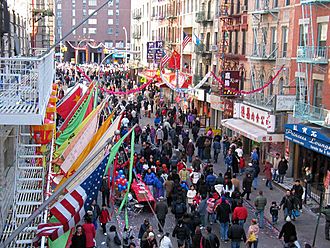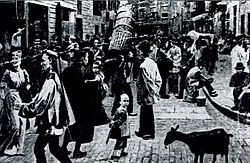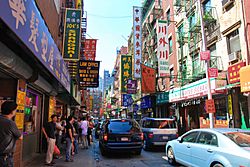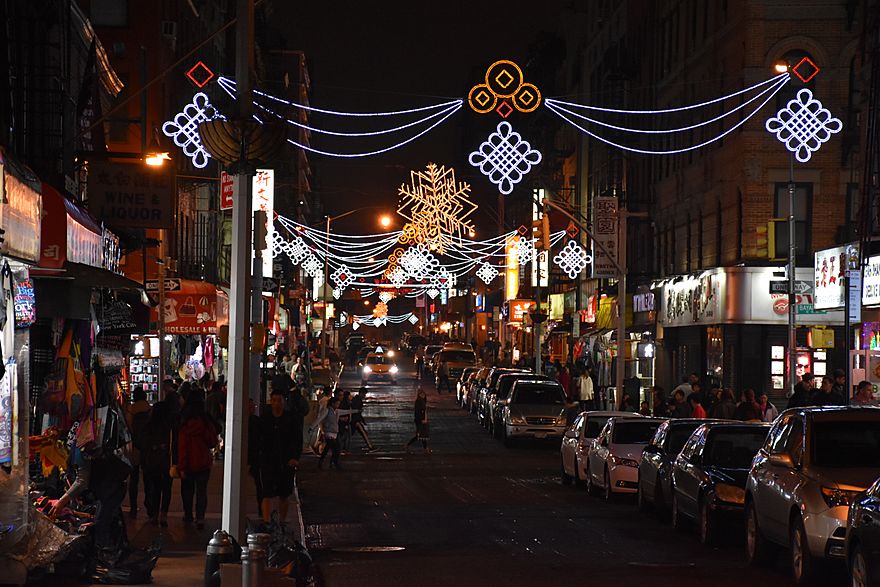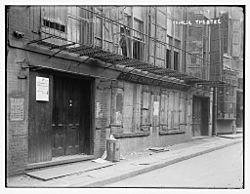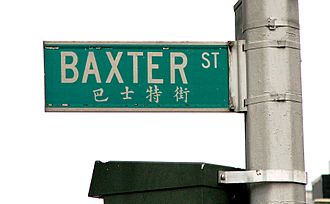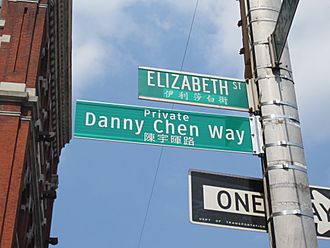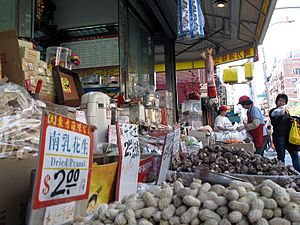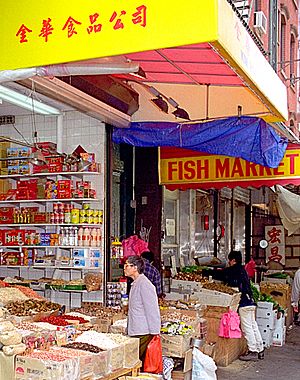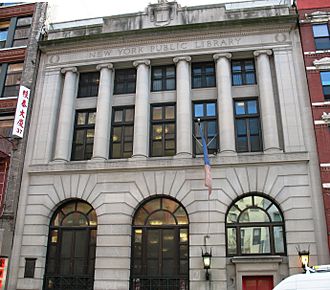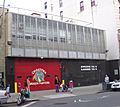Chinatown, Manhattan facts for kids
Quick facts for kids
Chinatown, Manhattan
曼哈頓華埠 |
|||||||||||||||||||||||||||||||||||||||||
|---|---|---|---|---|---|---|---|---|---|---|---|---|---|---|---|---|---|---|---|---|---|---|---|---|---|---|---|---|---|---|---|---|---|---|---|---|---|---|---|---|---|
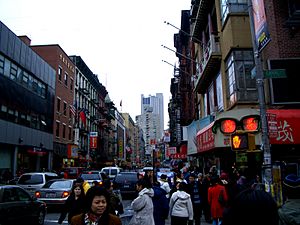
Crossing Canal Street in Chinatown, facing Mott Street toward the south
|
|||||||||||||||||||||||||||||||||||||||||
| Country | |||||||||||||||||||||||||||||||||||||||||
| State | |||||||||||||||||||||||||||||||||||||||||
| City | New York City | ||||||||||||||||||||||||||||||||||||||||
| Borough | Manhattan | ||||||||||||||||||||||||||||||||||||||||
| Community District | Manhattan 3 | ||||||||||||||||||||||||||||||||||||||||
| Area | |||||||||||||||||||||||||||||||||||||||||
| • Total | 1.99 km2 (0.768 sq mi) | ||||||||||||||||||||||||||||||||||||||||
| Population
(2010)
|
|||||||||||||||||||||||||||||||||||||||||
| • Total | 47,844 | ||||||||||||||||||||||||||||||||||||||||
| • Density | 24,053/km2 (62,300/sq mi) | ||||||||||||||||||||||||||||||||||||||||
| Ethnicity | |||||||||||||||||||||||||||||||||||||||||
| • Asian | 63.9% | ||||||||||||||||||||||||||||||||||||||||
| • White | 16.3% | ||||||||||||||||||||||||||||||||||||||||
| • Hispanic | 13.4% | ||||||||||||||||||||||||||||||||||||||||
| • Black | 4.8% | ||||||||||||||||||||||||||||||||||||||||
| • Other | 1.6% | ||||||||||||||||||||||||||||||||||||||||
| Economics | |||||||||||||||||||||||||||||||||||||||||
| • Median income | $68,657 | ||||||||||||||||||||||||||||||||||||||||
| Time zone | UTC−5 (Eastern) | ||||||||||||||||||||||||||||||||||||||||
| • Summer (DST) | UTC−4 (EDT) | ||||||||||||||||||||||||||||||||||||||||
| ZIP Codes |
10002, 10013
|
||||||||||||||||||||||||||||||||||||||||
| Area code | 212, 332, 646, and 917 | ||||||||||||||||||||||||||||||||||||||||
|
|||||||||||||||||||||||||||||||||||||||||
Manhattan's Chinatown (simplified Chinese: 曼哈顿华埠; traditional Chinese: 曼哈頓華埠; Mandarin Pinyin: Mànhādùn huábù; Jyutping: Maan6haa1deon6 waa4bou6) is a neighborhood in Lower Manhattan, New York City, bordering the Lower East Side to its east, Little Italy to its north, Civic Center to its south, and Tribeca to its west. With an estimated population of 90,000 to 100,000 people, Chinatown is home to the highest concentration of Chinese people in the Western Hemisphere. Manhattan's Chinatown is also one of the oldest Chinese ethnic enclaves. The Manhattan Chinatown is one of nine Chinatown neighborhoods in New York City, as well as one of twelve in the New York metropolitan area, which contains the largest ethnic Chinese population outside of Asia, comprising an estimated 893,697 uniracial individuals as of 2017.
Historically, Chinatown was primarily populated by Cantonese speakers. However, in the 1980s and 1990s, large numbers of Fuzhounese-speaking immigrants also arrived and formed a sub-neighborhood annexed to the eastern portion of Chinatown east of The Bowery, which has become known as Little Fuzhou (小福州) subdivided away from the primarily Cantonese populated original longtime established Chinatown of Manhattan from the proximity of The Bowery going west, known as Little Hong Kong/Guangdong (小粵港). As many Fuzhounese and Cantonese speakers now speak Mandarin—the official language in Mainland China and Taiwan—in addition to their native languages, this has made it more important for Chinatown residents to learn and speak Mandarin. Although now overtaken in size by the rapidly growing Flushing Chinatown (法拉盛華埠) (located in the New York City borough of Queens) and Brooklyn Chinatown (布魯克林華埠), the Manhattan Chinatown remains a dominant cultural force for the Chinese diaspora, as home to the Museum of Chinese in America and as the headquarters of numerous publications based both in the U.S. and China that are geared to overseas Chinese.
Chinatown is part of Manhattan Community District 3, and its primary ZIP Codes are 10013 and 10002. It is patrolled by the 5th Precinct of the New York City Police Department.
Contents
Location
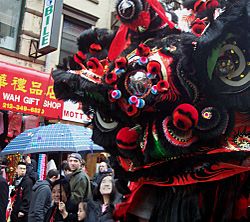
Although a Business Improvement District has been identified for support, Chinatown has no officially defined borders, but they have been commonly considered to be approximated by the following streets:
- Grand Street to the north, overlapping Little Italy
- Worth Street to the southwest, bordering Civic Center
- East Broadway to the southeast, bordering Two Bridges
- Allen Street to the east, bordering the Lower East Side
- Lafayette Street to the west, bordering Tribeca
Demographics and culture
In 2000, most of Chinatown's residents came from Asia. That year, the number of residents was 84,840, and 66% of them were Asian.
Demographics
The census tabulation area for Chinatown is bounded to the north by Houston Street; to the east by Avenue B, Norfolk Street, Essex Street and Pike Street; to the south by Frankfort Street; and to the west by Centre Street and Bowery. Based on data from the 2010 United States Census, the population of Chinatown was 47,844, a change of -4,531 (-9.5%) from the 52,375 counted in 2000. Covering an area of 332.27 acres (134.46 ha), the neighborhood had a population density of 144 inhabitants per acre (92,000/sq mi; 36,000/km2). The racial makeup of the neighborhood was 16.3% (7,817) White, 4.8% (2,285) African American, 0.1% (38) Native American, 63.9% (30,559) Asian, 0% (11) Pacific Islander, 0.2% (75) from other races, and 1.3% (639) from two or more races. Hispanic or Latino of any race were 13.4% (6,420) of the population.
The racial composition of Chinatown changed substantially from 2000 to 2010, with the most significant changes being the increase in the White population by 42% (2,321), the decrease in the Asian population by 15% (5,461), and the decrease in the Hispanic / Latino population by 15% (1,121). The Black population decreased by 3% (62) and remained a small minority, while the very small population of all other races decreased by 21% (208).
Chinatown lies in Manhattan Community District 3, which encompasses Chinatown, the East Village, and the Lower East Side. Community District 3 had 171,103 residents as of NYC Health's 2018 Community Health Profile, with an average life expectancy of 82.2 years. This is higher than the median life expectancy of 81.2 for all New York City neighborhoods. Most residents are adults: a plurality (35%) are between the ages of 25–44, while 25% are between 45–64, and 16% are 65 or older. The ratio of youth and college-aged residents was lower, at 13% and 11% respectively.
As of 2017, the median household income in Community District 3 was $39,584, though the median income in Chinatown individually was $68,657. In 2018, an estimated 18% of Community District 3 residents lived in poverty, compared to 14% in all of Manhattan and 20% in all of New York City. One in twelve residents (8%) were unemployed, compared to 7% in Manhattan and 9% in New York City. Rent burden, or the percentage of residents who have difficulty paying their rent, is 48% in Community District 3, compared to the boroughwide and citywide rates of 45% and 51% respectively. Based on this calculation, as of 2018[update], Community District 3 is considered to be gentrifying: according to the Community Health Profile, the district was low-income in 1990 and has seen above-median rent growth up to 2010.
The New York City Department of City Planning released updated 2020 census data on the Asian population of New York City. Manhattan's Chinatown has only 27,200 Asian residents, compared to the neighborhoods of Bensonhurst, Brooklyn (46,000); Sunset Park, Brooklyn (31,400); Flushing, Queens (54,200); and Elmhurst, Queens (55,800).
Chinese cultural standards
Despite the more recently emerged large Fuzhou population, many of the Chinese businesses in Chinatown are still Cantonese owned. The Cantonese dominated western section of Chinatown also continues to be the main busy Chinese business district. As a result, it has influenced many Fuzhouese to learn Cantonese for businesses, especially large businesses like the Dim Sum restaurants on what is known as Little Fuzhou on East Broadway (小福州). The Fuzhouese, the subgroup of non-Cantonese-speaking Chinese with the most interactions with Cantonese, also constitute the majority of non-native Cantonese-speaking Chinese. Many of the Fuzhou immigrants in the 1980s and early 1990s learned to speak Cantonese to maintain jobs and communicate with the Cantonese-speaking population in addition to the fact many of the earlier Fuzhou immigrants had lived in Hong Kong adapting into the Hong Kong culture and speaking Cantonese, which gave them better advantages to integrating into the Chinatown community as it was still very dominantly Cantonese speaking. However, since the 2000s, newer Chinese immigrants have largely spoken Mandarin Chinese, the national language of China.
A significant difference between the two separate Chinese provincial communities in Manhattan's Chinatown is that the Cantonese part of Chinatown not only serves Chinese customers but is also a tourist attraction. However, the Fuzhou part of Chinatown caters less to tourists. Bowery, Chrystie Street, Catherine Street, and Chatham Square encompass the approximate border zone between the Fuzhou and Cantonese communities in Manhattan's Chinatown.
Unlike most other urban Chinatowns, Manhattan's Chinatown is both a residential area as well as commercial area. Many population estimates are in the range of 90,000 to 100,000 residents. One analysis of census data in 2011 showed that Chinatown and heavily Chinese tracts on the Lower East Side had 47,844 residents in the 2010 census, a decrease of nearly 9% since 2000.
Gentrification and decline in Chinese population
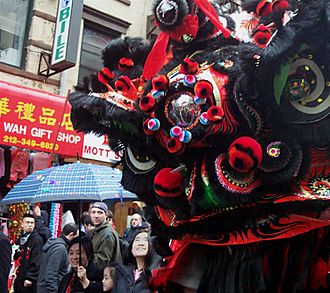
By 2007, luxury condominiums began to spread from SoHo into Chinatown. Previously, Chinatown was noted for its crowded tenements and primarily Chinese residents. While some projects have targeted the Chinese community, the development of luxury housing has increased Chinatown's economic and cultural diversity.
Since the early 2000s, there has been a continuously increasing number of buildings in Chinatown, neighboring Two Bridges, and the Lower East Side, taken over by new landlords and real estate developers, who then charged higher rents and/or demolished the buildings to build newer structures. Often, whenever this happens, many Fuzhouese tenants are more likely to be evicted, especially in the eastern portion of Chinatown, where illegal subdivision, overcrowding, lack of leases, and lack of immigrant paperwork are common. In addition, since the 2000s, there have been city officials inspecting apartment buildings and cracking down on illegal units. With tenants that have rent-stabilized leases, legal residency documents, no apartment subdivisions, and a lesser probability of subletting over capacity—most of whom are long-time Cantonese residents—it is usually harder for the newer landlords to be able to force these tenants out, especially including the western portion of Chinatown, which is still mainly Cantonese populated. However, newer landlords still continuously try find other loopholes to force them out.
By 2009, many newer Chinese immigrants settled along East Broadway instead of the historic core west of Bowery. In addition Mandarin began to eclipse Cantonese as the predominant Chinese dialect in New York's Chinatown during the period. The New York Times says that the Flushing Chinatown now rivals Manhattan's Chinatown in terms of being a cultural center for Chinese-speaking New Yorkers' politics and trade.
Current status as Chinese shopping business district
Despite the area's gentrification, it is still a popular Chinese commercial shopping district, frequented by residents of the New York metropolitan area as well as tourists. In addition, high-income professionals are moving into the area and patronizing Chinese businesses. However, commercial activity is not concentrated evenly through Chinatown. The western half of Chinatown (the original Cantonese Chinatown), known as Little Hong Kong/Guangdong, is still relatively active. However, the eastern/southern part of Chinatown, known as Little Fuzhou, has become primarily residential, and thus, the most primarily affected by the decline in business. Businesses in Little Fuzhou may be affected by the spread of gentrification from the nearby Lower East Side and East Village.
In 2016, the oldest continuously run business in Manhattan’s Chinatown was up for sale: Wing on Wo and Co, established in 1890. The building was worth around $10 million, including six stories and a store front, one of the only buildings left of its kind in the area. Mei Lum, a grandchild of the original owner, stepped in before the sale, deciding to take over the business and preserve its history and position within the neighborhood, to "regenerate, encourage and protect" Chinatown's culture. Lum started the "W.O.W. Project", which hopes to "preserve Chinatown’s creative scene through art and activism". Events such as Open Mic nights and exhibitions would start conversations about this neighborhood's past and the people that have lived there. For example, in February 2020, the W.O.W. Project exhibited ethnographic research and oral history interviews that highlighted stories of migration, displacement, and everyday resilience in Chinatowns all over the world. In response to the COVID-19 pandemic in New York City, the W.O.W. Project started a project called Love Letters to Chinatown.
History
Ah Ken and early Chinese immigration
| Historical population | |||
|---|---|---|---|
| Census | Pop. | %± | |
| 1990 | 51,439 | — | |
| 2000 | 59,320 | 15.3% | |
| 2010 | 52,613 | −11.3% | |
| Asian American population | |||
Ah Ken is claimed to have arrived in the area during the 1840s; he is the first Chinese person credited as having permanently immigrated to Chinatown. As a Cantonese businessman, Ah Ken eventually founded a successful cigar store on Park Row. He first arrived around 1858 in New York City, where he was "probably one of those Chinese mentioned in gossip of the sixties [1860s] as peddling 'awful' cigars at three cents apiece from little stands along the City Hall park fence – offering a paper spill and a tiny oil lamp as a lighter", according to author Alvin Harlow in Old Bowery Days: The Chronicles of a Famous Street (1931).
Later immigrants would similarly find work as "cigar men" or carrying billboards, and Ah Ken's particular success encouraged cigar makers William Longford, John Occoo, and John Ava to also ply their trade in Chinatown, eventually forming a monopoly on the cigar trade. It has been speculated that it may have been Ah Ken who kept a small boarding house on lower Mott Street and rented out bunks to the first Chinese immigrants to arrive in Chinatown. It was with the profits he earned as a landlord, earning an average of $100 a month, that he was able to open his Park Row smoke shop around which modern-day Chinatown would grow.
Chinese exclusion period
Faced with increasing racial discrimination and new laws that prevented participation in many occupations on the U.S. West Coast, some Chinese immigrants moved to the East Coast cities in search of employment. Early businesses in these cities included hand laundries and restaurants. Chinatown started on Mott, Park (now Mosco), Pell, and Doyers Streets, east of the notorious Five Points district. By 1870, there was a Chinese population of 200. By the time the Chinese Exclusion Act of 1882 was passed, the population was up to 2,000 residents. In 1900, the US Census reported 7,028 Chinese males in residence, but only 142 Chinese women. This significant gender inequality remained present until the repeal of the Chinese Exclusion Act in 1943. Wenfei Wang, Shangyi Zhou, and C. Cindy Fan, authors of "Growth and Decline of Muslim Hui Enclaves in Beijing", wrote that because of immigration restrictions, Chinatown continued to be "virtually a bachelor society" until 1965.
The early days of Chinatown were dominated by Chinese "tongs" (now sometimes rendered neutrally as "associations"), which were a mixture of clan associations, landsman's associations, political alliances (Kuomintang (Nationalists) vs Communist Party of China), and more secretly, crime syndicates. The associations started to give protection from harassment due to anti-Chinese sentiment. Each of these associations was aligned with a street gang. The associations were a source of assistance to new immigrants, giving out loans, aiding in starting businesses, and so forth. The associations formed a governing body named the Chinese Consolidated Benevolent Association (中華公所). Though this body was meant to foster relations between the Tongs, open warfare periodically flared between the On Leong (安良) and Hip Sing (協勝) tongs. Much of the Chinese gang warfare took place on Doyers street. Gangs like the Ghost Shadows (鬼影) and Flying Dragons (飛龍) were prevalent until the 1990s. The Chinese gangs controlled certain territories of Manhattan's Chinatown. The On Leong (安良) and its affiliate Ghost Shadows (鬼影) were of Cantonese and Toishan descent, and controlled Mott, Bayard, Canal, and Mulberry Streets. The Flying Dragons (飛龍) and its affiliate Hip Sing (協勝) also of Cantonese and Toishan descent controlled Doyers, Pell, Bowery, Grand, and Hester Streets. Other Chinese gangs also existed, like the Hung Ching and Chih Kung gangs of Cantonese and Toishan descent, which were affiliated with each other and also gained control of Mott Street. Born to Kill, also known as the Canal Boys, a gang composed almost entirely of Vietnamese immigrants from the Vietnam War under the leadership of David Thai had control over Broadway, Canal, Baxter, Centre, and Lafayette Streets. Fujianese gangs also existed, such as the Tung On gang, which affiliated with Tsung Tsin, and had control over East Broadway, Catherine and Division Streets and the Fuk Ching gang affiliated with Fukien American controlled East Broadway, Chrystie, Forsyth, Eldridge, and Allen Streets. At one point, a gang named the Freemasons gang, which were of Cantonese descent, had attempted to claim East Broadway as their territory.
Columbus Park, the only park in Chinatown, was built on what was once the center of the infamous Five Points neighborhood. During the 19th century, this was the most dangerous ghetto area of immigrant New York, as portrayed in the book and film Gangs of New York.
After immigration reform
In the years after the United States enacted the Immigration and Nationality Act of 1965, allowing many more immigrants from Asia into the country, the population of Chinatown increased dramatically. Geographically, much of the growth was to neighborhoods to the north. The Chinatown grew and became more oriented on families due to the lifting of restrictions. In the earliest years of the existence of Manhattan's Chinatown, it had been primarily populated by Taishanese-speaking Chinese immigrants and the borderlines of the enclave was originally Canal Street to the north, Bowery to the east, Worth Street to the south, and Mulberry Street to the west. However, after 1965, there came a wave of Cantonese speakers from Hong Kong and Guangdong province in Mainland China, and Standard Cantonese became the dominant tongue. With the influx of Hong Kong immigrants, it was developing and growing into a Hong Kongese neighborhood, however the growth slowed down later on during the 1980s-90s.
Through the 1970s and 1980s, the influx of Guangdong and Hong Kong immigrants began to develop newer portions of Manhattan's Chinatown going north of Canal Street and then later the east of the Bowery. However until the 1980s, the western section was the most primarily fully Chinese developed and populated part of Chinatown and the most quickly flourishing busy central Chinese business district with still a little bit of remaining Italians in the very north west portion around Grand Street and Broome Street, which eventually all moved away and became all Chinese by the 1990s. However, until the 1980s, the portion of Chinatown that is east of the Bowery—which is considered part of the Lower East Side—was developing more slowly as being part of Chinatown, the proportion and concentration of Chinese residents was lower and more scattered than the western section, and there was still a higher proportion of Non-Chinese residents than Chinatown's western section consisting of Jewish, Puerto Ricans, and a few Italians and African Americans.
Starting in the 1970s and especially throughout the 1980s-90s, Mandarin-speaking Taiwanese immigrants and then later on many other Non-Cantonese Chinese immigrants also were arriving into New York City. However, due to the traditional dominance of Cantonese-speaking residents, which were largely working class in Manhattan's Chinatown and the neighborhood's poor housing conditions, they were unable to relate to Manhattan's Chinatown and mainly settled in Flushing and created a more middle class Mandarin-Speaking Chinatown or Mandarin Town (國語埠) and even smaller one in Elmhurst, since most of the newer upcoming generations of ethnic Chinese were already using Mandarin although still their regional dialects in everyday conversations, whereas Cantonese speaking populations largely don't speak Mandarin or only speak it with other Non-Cantonese Chinese speakers. As a result, Manhattan's Chinatown and Brooklyn's emerging Chinatown were able to continue retaining its traditional almost exclusive Cantonese society and were nearly successful at permanently keeping its Cantonese dominance. However, there was already a small and slow growing Fuzhou immigrant population in Manhattan's Chinatown since the 1970s-80s in the eastern section of Chinatown east of the Bowery, which was still underdeveloped as being part of Chinatown. In the 1990s, though, Chinese people began to move into some parts of the western Lower East Side, which 50 years earlier was populated by Eastern European Jews and 20 years earlier was occupied by Hispanics.
Migration to Brooklyn Chinatown
During the late 1980s and 1990s, most of the new Fuzhou immigrants arriving into New York City were settling in Manhattan's Chinatown and later formed the first Fuzhou community in the city amongst the waves of Cantonese who had settled in Chinatown over decades. However, by the 2000s, the increasing Fuzhou influx had shifted into the Brooklyn Chinatown in the Sunset Park section of the Brooklyn borough of New York City. This shift replaces the Cantonese population throughout Brooklyn's Sunset Park Chinatown significantly more rapidly than in Manhattan's Chinatown. Brooklyn's Sunset Park Chinatown is becoming the new Little Fuzhou in NYC, or figuratively, Brooklyn's East Broadway (布魯克林區的東百老匯). In addition, Brooklyn's Little Fuzhou has now challenged and increasingly marginalizing Manhattan's Chinatown's Little Fuzhou's status as the primary center of Fuzhou population and culture of New York City. Gentrification in Manhattan's Chinatown has slowed the growth of Fuzhou immigration as well as the growth of Chinese immigrants to Manhattan in general, which is why New York City's rapidly growing Chinese population has now shifted primarily to the boroughs of Queens and Brooklyn.
Some Chinese landlords in Manhattan, especially the many real estate agencies that are mainly of Cantonese ownership, were accused of prejudice against the Fuzhou immigrants, supposedly making Fuzhou immigrants feel unwelcome because concerns that they would not be able to pay rent or debt to gangs that may have helped smuggled them in illegally into the United States, and because of fear that gangs will come up to the apartments to cause trouble. There is also supposedly a concern that Fujianese are more likely to make the apartments too overcrowded by subdividing an apartment into multiple small spaces to rent to other Fuzhou immigrants. East Broadway, Manhattan's center of Fuzhou culture, has perhaps the most blatant results of illegal apartment subdivisions including having many bunk beds in just one small room. As a result of fear of being evicted by Cantonese landlords, many Fuzhou immigrants resort to renting a tiny space from Fujianese landlords inside apartments already occupied by Fuzhou immigrants.
Although Mandarin is spoken as a native language among only ten percent of Chinese speakers in Manhattan's Chinatown, it is used as a secondary dialect among the greatest number of them. Although Min Chinese, especially the Fuzhou dialect, is spoken natively by a third of the Chinese population in the city, it is not used as a lingua franca because speakers of other dialect groups do not learn Min.
Gentrification
Currently, the rising prices of Manhattan real estate and high rents are also affecting Chinatown. Many new and poorer Chinese immigrants cannot afford their rents; as a result, most of the growth in new Chinese immigration has shifted to other Chinatowns in New York City, including the Flushing Chinatown and Elmhurst Chinatown in Queens; the Brooklyn Chinatown and its satellite Chinatowns in Brooklyn on Avenue U and in Bensonhurst; and to East Harlem in Upper Manhattan. Many apartments, particularly in the Lower East Side and Little Italy, which used to be affordable to new Chinese immigrants, are being renovated and then sold or rented at much higher prices. Building owners, many of them established Chinese-Americans, often find it in their best interest to terminate leases of lower-income residents with stabilized rents as property values rise.
By 2007, luxury condominiums began to spread from SoHo into Chinatown. Previously Chinatown was noted for its crowded tenements and primarily Chinese residents. While some projects have targeted the Chinese community, the development of luxury housing has increased Chinatown's economic and cultural diversity.
Since the early 2000s, there has been a continuously increasing number of buildings in Chinatown, neighboring Two Bridges, and the Lower East Side, taken over by new landlords and real estate developers, who then charged higher rents and/or demolished the buildings to build newer structures. Often, whenever this happens, many Fuzhouese tenants are more likely to be evicted, especially in the Eastern Portion of Manhattan's Chinatown, where many of the apartment buildings hold the vast majority of Fuzhou tenant population due to the majority of Fuzhou people in legal risks such as illegal apartment subdivision; often excessive occupancy overcrowding, lack of leases, and lack of immigrant paperwork; these legal risks were often overlooked by the original, Chinese landlords. In addition, within recent years since the 2000s, there have been city officials inspecting apartment buildings and cracking down on illegally subdivided apartments and kicking out the occupants throughout Manhattan's Chinatown, however the Fuzhou occupied apartments have been the primary main targets of these crackdowns and mostly in the eastern section of Manhattan's Chinatown where the Fuzhou population is primarily concentrated.
With tenants that have rent-stabilized leases, legal residency documents, no apartment subdivisions, and a lesser probability of subletting over capacity—most of whom are long-time Cantonese residents—it is usually harder for the newer landlords to be able to force these tenants out, especially including the western portion of Chinatown, which is still mainly Cantonese populated. However, newer landlords still continuously try find other loopholes to force them out.
By 2009 many newer Chinese immigrants settled along East Broadway instead of the historic core west of Bowery. In addition Mandarin began to eclipse Cantonese as the predominant Chinese dialect in New York's Chinatown during the period. The New York Times says that the Flushing Chinatown now rivals Manhattan's Chinatown in terms of being a cultural center for Chinese-speaking New Yorkers' politics and trade.
Streetscape
Population and culture
In 2000, most of Chinatown's residents came from Asia. That year, the number of residents was 84,840, and 66% of this people were Asian.
Unlike most other urban Chinatowns, Manhattan's Chinatown is both a residential area as well as commercial area. Many population estimates are in the range of 90,000 to 100,000 residents. One analysis of census data in 2011 showed that Chinatown and heavily Chinese tracts on the Lower East Side had 47,844 residents in the 2010 census, a decrease of nearly 9% since 2000.
Little Fuzhou
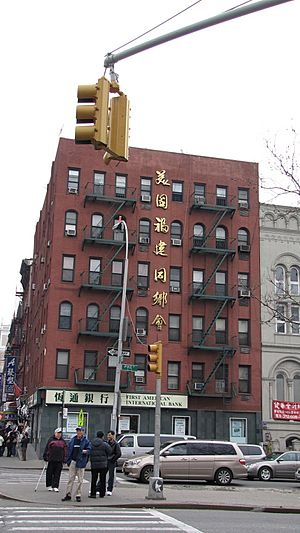
From the late 1980s through the 1990s, when a large influx of Fuzhou immigrants, who also largely speak Mandarin along with their Fuzhou dialect started to arrive into New York City, they were the only exceptional Non-Cantonese Chinese group to largely settle in Manhattan's Chinatown and eventually Brooklyn's Chinatown, which was also originally Cantonese dominated. This is due to many of them having no legal status and being forced into the lowest paying jobs, Manhattan's Chinatown was the only place they can receive affordable housing and be around other Chinese people despite the heavy Cantonese dominance until the 1990s since the more Mandarin-speaking enclaves in Flushing and Elmhurst would be too expensive to rent a vacancy.
Since the Fuzhou immigrants have a strong cultural and linguistic background difference from the Cantonese people, the Fuzhou immigrants were unable to integrate well into Manhattan's Chinatown, which was still very Cantonese dominated and as a result they settled in the eastern portion of Chinatown, which was still an overlap of Chinese, Hispanics and Jewish in addition the higher availability of housing vacancies is another reason why they settled in that section. The eastern section became more fully developed as being part of Chinatown, and these new immigrants began to establish their own Fuzhou community along East Broadway and Eldridge Street. This has resulted in referring to East Broadway as Fuzhou Street No. 1, emerged during the late 1980s-early 1990s and Eldridge Street as Fuzhou Street No. 2, which developed more towards after the mid 1990s-early 2000s.
Little Fuzhou started becoming known as the new Chinatown of Manhattan, separate from the long time heavily dominated Cantonese community, which is the western section of Chinatown or the Old Chinatown of Manhattan; although significant minor to moderate numbers of long time Cantonese people and businesses still continue to exist in the eastern portion of Chinatown.
Very soon, in the early 2000s, gentrification immediately came into Manhattan's Chinatown and in addition to the shortage of housing vacancies, it caused the Fuzhou influx to shift to Brooklyn's Chinatown, which was now the most affordable New York City Chinese enclave to live in and unlike in Manhattan's Chinatown where the Fuzhou population continues to be mainly concentrated, although now slowly declining due to gentrification in the East Broadway and Eldridge Street portion, the Fuzhou immigrant population has now managed to dominate the whole Brooklyn's Chinatown diluting the Cantonese population as well as beginning to sideline Manhattan's Chinatown's Little Fuzhou as the Fuzhou cultural center in New York City. Brooklyn's Chinatown then became more fully developed and as well as causing its ethnic enclave size to expand tremendously as a result of the shift of the Fuzhou influx.
Not only did the Fuzhou immigration influx establish a new portion of Manhattan's Chinatown, they contributed significantly in maintaining the Chinese population in the neighborhood, they also played a role in property values increasing quickly during the 1990s, in contrast to during the 1980s, when the housing prices were dropping. As a result, landlords were able to generate twice as much income in Manhattan's Chinatown, Flushing's Chinatown and eventually Brooklyn's Chinatown.
Little Hong Kong
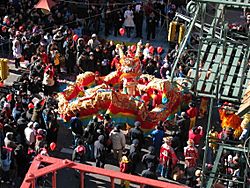
As the epicenter of the massive Fuzhou influx has shifted to Brooklyn in the 2000s, Manhattan's Chinatown's Cantonese population still remains viable and large and successfully continues to retain its stable Cantonese community identity, maintaining the communal gathering venue established decades ago in the western portion of Chinatown, to shop, work, and socialize—in contrast to the Cantonese population and community identity which are shifting from Brooklyn's original Sunset Park Chinatown to the satellite Chinatowns in Brooklyn.
Although the term Little Hong Kong (小香港) was used a long time ago to describe Manhattan's Chinatown relating to when an influx of Hong Kong immigrants were pouring in at that time and even though not all Cantonese immigrants come from Hong Kong, this portion of Chinatown has heavy Cantonese characteristics, especially with the Standard Cantonese, which is spoken in Hong Kong and Guangzhou, China being widely used, so it is in many ways a Little Hong Kong.
A more appropriate term would be Little Guangdong (小廣東) or Cantonese Town (廣東埠) since the Cantonese immigrants do come from different regions of the Guangdong province of China. The long time established Cantonese Community, which can be considered Little Hong Kong/Guang Dong or known as the Old Chinatown of Manhattan lies along Mott, Pell, Doyer, Bayard, Elizabeth, Mulberry, Canal, and Bowery Streets, within Manhattan's Chinatown.
Newer satellite Little GuangDong/Little Hong Kong have started to emerge in sections of Bensonhurst and in Sheepshead Bay/Homecrest in Brooklyn. However, there are more scattered and mixed in with other ethnic enclaves. This is a result of many Cantonese residents migrating to these neighborhoods. Originally Brooklyn's Chinatown in Sunset Park was a satellite of Manhattan's Western Cantonese Chinatown, but because of the massive Fuzhou influx to Brooklyn in the 2000s, and with the Cantonese residents now shifting to Brooklyn's own satellite Chinatowns, the original Sunset Park, Brooklyn Chinatown has since become a satellite of Manhattan's Little Fuzhou itself.
Fuzhouese-Cantonese relations
The Fuzhou immigration pattern started out in the 1970s very similarly like the Cantonese immigration during the late 1800s to early 1900s that had established Manhattan's Chinatown on Mott Street, Pell Street, and Doyers Street. Starting out as mostly men arriving first and then later on bringing their families over. The beginning influx of Fuzhou immigrants arriving during the 1980s and 1990s were entering into a Chinese community that was extremely Cantonese dominated. Due to the Fuzhou immigrants having no legal status and inability to speak Cantonese, many were denied jobs in Chinatown as a result causing many of them to resort to crimes to make a living that began to dominate the crimes going on in Chinatown. There was a lot of Cantonese resentment against Fuzhou immigrants arriving into Chinatown.
Chinese cultural standards
Despite the large Fuzhou population, many of the Chinese businesses in Chinatown are still Cantonese owned and because of still the large Cantonese population on the Lower East Side, Cantonese still carries a strong presence in Chinatown including to the additional large influx of Cantonese speaking customers coming from other places to neighborhood on the weekends to do shopping and eat in restaurants even though Mandarin Chinese is rapidly sweeping Cantonese aside as the lingua franca of Chinatown, allowing Cantonese to continue to exert a significant level of influence upon the cultural standards and economic resources of Manhattan's Chinatown. The Cantonese dominated western section of Chinatown also continues to be the main busy Chinese business district.
As a result, it has influenced many Fuzhou people to learn the Cantonese language as well to maintain a job and to be able to bring more Cantonese customers as additional contributions to their businesses, especially large businesses like the Dim Sum restaurants on what is known as Little Fuzhou on East Broadway (小福州), the center of Fuzhou culture. Due to many Fuzhou immigrants having the most interaction with Cantonese people out all of the other Non-Cantonese Chinese people, the Fuzhou immigrants that mastered the Cantonese language constitute the vast majority of Chinese people who are not native Cantonese speakers, but learned to speak Cantonese in NYC. Linguistically, however, in the past few years, the Cantonese dialect that has dominated Chinatown for decades is being swiftly uprooted by Mandarin Chinese, the national language of China and the lingua franca of most of the latest Chinese immigrants.
A significant difference between the two separate Chinese provincial communities in Manhattan's Chinatown is that the Cantonese part of Chinatown not only serves Chinese customers but is also a tourist attraction, whereas the Fuzhou part of Chinatown caters less to tourists, but it is now slowly receiving tourists as well. Bowery, Chrystie Street, Catherine Street, and Chatham Square encompass the approximate border zone between the Fuzhou and Cantonese communities in Manhattan's Chinatown.
Satellite Chinatowns
For a long time, Manhattan's Chinatown has always been the most largely concentrated Chinese population in NYC, which is 6% Chinese American overall. However, in recent years growing Chinese populations in the outer boroughs of NYC have tremendously outnumbered Manhattan's Chinese population. Other New York City Chinese communities have been settled over the years, including that of Flushing in Queens, particularly along from Roosevelt Avenue to Main Street through Kissena Blvd.
Another Chinese community is located in Sunset Park in Brooklyn, particularly along 8th Avenue from 40th to 65th Streets. New York City's newer Chinatowns have recently sprung up in Elmhurst and Corona, Queens (which border each other and are part of the same Chinatown), on Avenue U in the Homecrest section of Brooklyn, as well as in Bensonhurst, also in Brooklyn. Outside of New York City proper, rapidly growing suburban Chinatowns are developing within the New York metropolitan area in nearby Edison, New Jersey and Nassau County, Long Island.
While the composition of these satellite Chinatowns are as varied as the original, the political factions in the original Manhattan Chinatown (Tongs, Republic of China loyalists, People's Republic of China loyalists, and those apathetic) have led to some factionalization in the satellite Chinatowns.
The Flushing Chinatown was spearheaded by many Chinese fleeing the Communist retaking of Hong Kong in 1997 as well as Taiwanese who used their considerable capital to buy out land from the former residents. The Brooklyn Chinatown was originally settled by Cantonese immigrants, but today it is mostly populated by Fujianese immigrants with still some Cantonese immigrants, who are longtime Chinese residents.
Buildings
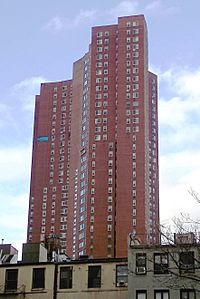
The housing stock of Chinatown is still mostly composed of cramped tenement buildings, some of which are over 100 years old. It is still common in such buildings to have bathrooms in the hallways, to be shared among multiple apartments. A federally subsidized housing project, named Confucius Plaza, was completed on the corner of Bowery and Division Street in 1976. This 44-story residential tower block gave much needed new housing stock to thousands of residents. The building also housed a new public grade school, P.S. 124 (or Yung Wing Elementary). Besides being the first and largest affordable housing complex specifically available to the Chinatown population Confucius Plaza is also a cultural and institutional landmark, springing forth community organization, Asian Americans for Equality (AAFE), one of Chinatown's oldest political/community organizations, founded in 1974.

For much of Chinatown's history, there were few unique architectural features to announce to visitors that they had arrived in the neighborhood (other than the language of the shop signs). In 1962, the Lieutenant Benjamin Ralph Kimlau Memorial archway at Chatham Square was erected in memorial of the Chinese-Americans who died in World War II. This memorial bears calligraphy by the great Yu Youren 于右任 (1879–1964). A statue of Lin Zexu (林則徐), also known as Commissioner Lin, a Foochowese Chinese official who opposed the opium trade, is also located at the square; it faces uptown along East Broadway, now home to the bustling Fuzhou neighborhood and known locally as Fuzhou Street (Fúzhóu jiē 福州街). In the 1970s, New York Telephone, then the local phone company, started capping the street phone booths with pagoda-like decorations. In 1976, the statue of Confucius in front of Confucius Plaza became a common meeting place. In the 1980s, banks which opened new branches and others which were renovating started to use Chinese traditional styles for their building facades. The Church of the Transfiguration, a national historic site built in 1815, stands off Mott Street. The Chinese American experience has been documented at the Museum of Chinese in America in Manhattan's Chinatown since 1980.
In 2010, Chinatown and Little Italy were listed in a single historic district on the National Register of Historic Places.
Chinese theaters
In the past, Chinatown had Chinese movie theaters that provided entertainment to the Chinese population. The first Chinese-language theater in the city was located at 5–7 Doyers Street from 1893 to 1911. The theater was later converted into a rescue mission for homeless from Bowery. In 1903, the theater was the site of a fundraiser by the Chinese community for Jewish victims of a massacre in Kishinev.
Among the theaters that existed in Chinatown in later years were the Sun Sing Theater under the Manhattan Bridge and the Pagoda Theater, both on the street of East Broadway, the Governor Theater on Chatham Square, the Rosemary Theater on Canal Street across the Manhattan Bridge, as well as the Music Palace on the Bowery, which was the last Chinese theater to close. Others have existed in different sections of Chinatown. The Chinese theaters also played movies with Chinese and English subtitles for the non-Chinese viewers, which were very often black Muslims that enjoyed movies with non-white heroes, These theaters now have all closed because of more accessibility to videotapes, which were more affordable and provided more genres of movies and much later on DVDs and VCDs became available. Other factors such as, availability of Chinese cable channels, karaoke bars, and gambling in casinos began to provide other options for the Chinese to have entertainment also influenced the Chinese theaters to go out of business.
Transportation
There are two New York City Subway stations that are directly in the neighborhood—Grand Street (B D) and Canal Street (4, 6 <6> J and Z N Q R W)—although other stations are also nearby. New York City Bus routes include M9, M15, M15 SBS, M22, M55, M103.
The Manhattan Bridge connects Chinatown to Downtown Brooklyn. The FDR Drive runs along the East River, where the East River Greenway, a pedestrian walkway and bikeway, is also present.
The major cultural streets are Mott Street and East Broadway; on the other hand, Canal Street, Allen Street, Delancey Street, Grand Street, East Broadway, and Bowery are the main traffic arteries.
There are multiple bike lanes in the area as well.
Street names in Chinese
Streets in Chinatown also have Chinese names, which are noted on bilingual street signs in Chinatown. Prior to the 1960s, Chinatown residents named the streets informally, and streets could carry several Chinese names. The first bilingual street signs installed by the city government were placed on police call boxes in 1966. The first 44 bilingual street signs, displaying the street name in English with a smaller street name in Chinese below, were installed in 1969. These signs were installed in an area bounded by Canal Street to the north, Bowery to the east, Chatham Square to the southeast, Worth Street to the south, and Mulberry Street to the west. The street names were selected to match phonetic transliterations of English names in Taishanese and Cantonese, the two Chinese varieties most frequently spoken in Chinatown at the time. As different Chinese varieties may have widely varying pronunciations for the same word, the signs did not account for pronunciations in Mandarin and Fujianese, the varieties spoken by many immigrants who came in the 1970s.
In the early 1980s, the program was expanded following an effort by urban planner Jerry S. Y. Cheng and Chinese Consolidated Benevolent Association (CCBA) president Li Boli. The New York City Department of Transportation commissioned a study in 1985 to identify places for new signs, but most records have been lost or destroyed. The expansion would have extended the signs north to Broome Street, east to Allen and Pike Streets, southeast to Madison Street (between Oliver and Pike Streets), and west to Lafayette Street. The newer street names were proposed by CCBA members and affiliated merchants, who mostly spoke Taishanese and Cantonese. Calligrapher Tan Bingzhong manually wrote the Chinese characters on street signs for 40 streets, leading to slight variations in each sign.
While there were 155 street signs at the program's peak, only 101 signs remained as of 2022[update], and almost half of the 40 streets no longer have bilingual signs. A New York Times analysis of the program found that many damaged signs were replaced with English-only signs, as translated street names are not part of the Manual on Uniform Traffic Control Devices, or else were not replaced at all. Furthermore, many of the people involved in the street-sign programs during the 1960s and 1980s had died, and the relocation of the neighborhood's Chinese residents had shrunken the area's Chinese presence over time. According to the Times, there was little awareness in the neighborhood that the bilingual signs were disappearing, even among community leaders.
| Street | Traditional Chinese | Pinyin | Jyutping |
|---|---|---|---|
| Allen Street | 亞倫街 | yǎ lún jiē | ngaa3 leon4 gaai1 |
| Baxter Street | 巴士特街 | bā shì tè jiē | baa1 si6 dak6 gaai1 |
| Bayard Street | 擺也街 | bǎi yě jiē | baai2 jaa5 gaai1 |
| Bowery | 包厘街 | bāo lí jiē | baau1 lei4 gaai1 |
| Broadway | 百老匯大道 | bǎilǎohuì dàdào | baak3 lou5 wui6 daai6 dou6 |
| Broome Street | 布隆街 | bù lóng jiē | bou3 lung4 gaai1 |
| Canal Street | 堅尼街 | jiān ní jiē | gin1 nei4 gaai1 |
| Catherine Street | 加薩林街 | jiā sà lín jiē | gaa1 saat3 lam4 gaai1 |
| Centre Street | 中央街 | zhōngyāng jiē | zung1 joeng1 gaai1 |
| Chambers Street | 錢伯斯街 | qián bó sī jiē | cin2 baak3 si1 gaai1 |
| Chatham Square | 且林士果 | qiě línshìguǒ | ce2 lam4 si6 gwo2 |
| Cherry Street | 車厘街 | Chē lí jiē | ce1 lei4 gaai1 |
| Chrystie Street | 企李士提街 | qǐ lǐ shì tí jiē | kei5 lei5 si6 tai4 gaai1 |
| Delancey Street | 地蘭西街 | de lán xī jiē | dei6 laan4 sai1 gaai1 |
| Division Street | 地威臣街 | de wēi chén jiē | dei6 wai1 san4 gaai1 |
| Doyers Street | 宰也街 | zǎi yě jiē | zoi2 jaa5 gaai1 |
| East Broadway (Little Fuzhou) |
東百老匯 (小福州) |
dōng bǎilǎohuì
(xiǎo fúzhōu) |
dung1 baak3 lou5 wui6
(siu2 fuk1 zau1) |
| Eldridge Street | 愛烈治街 | ài liè zhì jiē | ngoi3 lit6 zi6 gaai1 |
| Elizabeth Street (Private Danny Chen Way) |
伊利莎白街 (陳宇暉路) |
yīlì shā bái jiē
(chén yǔ huī lù) |
ji1 lei6 saa1 baak6 gaai1
(can4 jyu5 fai1 lou6) |
| Forsyth Street | 科西街 | kē xī jiē | fo1 sai1 gaai1 |
| Grand Street | 格蘭街 | gé lán jiē | gaak3 laan4 gaai1 |
| Henry Street | 顯利街 | xiǎn lì jiē | hin2 lei6 gaai1 |
| Hester Street | 喜士打街 | xǐ shì dǎ jiē | hei2 si6 daa2 gaai1 |
| Ludlow Street | 拉德洛街 | lā dé luò jiē | laai1 dak1 lok6 gaai1 |
| Madison Street | 麥地遜街 | mài dì xùn jiē | mak6 dei6 seon3 gaai1 |
| Market Street | 市場街 | shìchǎng jiē | si5 coeng4 gaai1 |
| Monroe Street | 門羅街 | mén luó jiē | mun4 lo4 gaai1 |
| Mosco Street | 莫斯科街 | mòsīkē jiē | mok6 si1 fo1 gaai1 |
| Mott Street (Little Hong Kong/Little Guangdong) |
勿街 (小香港)/(小廣東) |
wù jiē
(xiǎo xiānggǎng) (xiǎo guǎngdōng) |
mat6 gaai1
(siu2 hoeng1 gong2) (siu2 gwong2 dung1) |
| Mulberry Street | 摩比利街 | mó bǐ lì jiē | mo1 bei2 lei6 gaai1 |
| Orchard Street | 柯察街 | kē chá jiē | o1 caat3 gaai1 |
| Park Row | 柏路 | bǎi lù | paak3 lou6 |
| Pell Street | 披露街 | pīlù jiē | pei1 lou6 gaai1 |
| Pike Street | 派街 | pài jiē | paai3 gaai1 |
| Rutgers Street | 羅格斯街 | Luó gé sī jiē | lo4 gaak3 si1 gaai1 |
| Water Street | 水街 | shuǐ jiē | seoi2 gaai1 |
| Worth Street | 窩夫街 | wō fū jiē | wo1 fu1 gaai1 |
| White Street | 白街 | bái jiē | baak6 gaai1 |
| South Street | 南街 | nán jiē | naam4 gaai1 |
Economy
Chinese greengrocers and fishmongers are clustered around Mott Street, Mulberry Street, Canal Street (by Baxter Street), and all along East Broadway (especially by Catherine Street). The Chinese jewelers' district is on Canal Street between Mott and Bowery. There are many Asian and American banks in the neighborhood. Canal Street, west of Broadway (especially on the Northside), is filled with street vendors selling knock-off brands of perfumes, watches, and handbags. This section of Canal Street was previously the home of warehouse stores selling surplus/salvage electronics and hardware.
In addition, tourism and restaurants are major industries. The district boasts many historical and cultural attractions, and it is a destination for tour companies like Manhattan Walking Tour, Big Onion, NYC Chinatown Tours, and Lower East Side History Project. Tour stops often include landmarks like the Church of the Transfiguration and the Lin Zexu and Confucius statues. The enclave's many restaurants also support the tourism industry. In Chinatown, more than 300 Chinese restaurants provide employment. Notable and well-reviewed Chinatown establishments include Joe's Shanghai, Jing Fong, New Green Bo and Amazing 66.
Other contributors to the economy include factories. The proximity of the fashion industry has kept some garment work in the local area, though much of the garment industry has since moved to China. The local garment industry now concentrates on quick production in small volumes and piece work, which is generally done at the worker's home. Much of the population growth is due to immigration.
The September 11, 2001 attacks caused a decline in business for stores and restaurants in Chinatown. Chinatown was adversely affected by the attacks; being so physically close to Ground Zero, Chinatown saw a very slow return of tourism and business. Part of the reason was the NYPD closure of Park Row, one of two major roads linking the Financial District with Chinatown (the other being Centre Street). However, the area's economy, as well as tourism, have rebounded since then. A Chinatown business improvement district was established in 2011 despite opposition from business owners in the community.
The neighborhood is home to several large Chinese supermarkets. In August 2011, a new branch of New York Supermarket opened on Mott Street in the central district of grocery and food shopping of Manhattan's Chinatown. Just a block away from New York Supermarket, is a Hong Kong Supermarket located on the corner of Elizabeth and Hester Streets. These two supermarkets are among the largest Chinese supermarkets carrying all different food varieties within the long-time established Cantonese community in the western section of Manhattan's Chinatown. A Hong Kong Supermarket at East Broadway and Pike Street burned down in 2009 and plans to construct a 91-room Marriott Hotel in its place resulted in community protests. The New York Supermarkets chain, which also operates markets in Elmhurst and Flushing, settled with the New York State Attorney General in 2008 in which it paid back wages and overtime to workers. Many of the Chinese restaurant menus in the U.S. are printed in Chinatown, Manhattan.
Manhattan's Chinatown has had a history of mini malls with varieties of small shops, however due to the gentrification, this trend has been declining. However, two significant well known mini malls in Manhattan's Chinatown still exist and stand out the most, which are Elizabeth Center at 13 Elizabeth Street right next to NYPD's 5th precinct and East Broadway Mall at 88 East Broadway under the Manhattan Bridge. Elizabeth Center is a Hong Kong style shopping center with varieties of shops with most of them being owned by Cantonese speakers along with some owned by other Chinese speakers as well and is located in the longer time established western Cantonese Chinatown, therefore their customer base are largely Cantonese speakers from the local neighborhoods as well as from other places, however other Chinese speakers from the local area and from other places including Chinese tourists also come to shop at this mini mall. Elizabeth Center also attracts a lot of Non-Asian tourists and visitors and it is often very popular with younger generation customers of Chinese and non-Chinese descents due to the significant concentration of stores that sell varieties of affordable accessories as well as cartoon figure and Action figure products. Since the 1990s, East Broadway Mall's shops have been mostly owned by Fuzhou speakers as this mini mall is located in the later developed eastern Fuzhou Chinatown catering mostly to Fuzhou speaking customers and it has had a reputation of having significant amount of employment agencies providing Fuzhou speakers with jobs in outer states as well as having bus stations set up around the proximity to transport the Fuzhou speakers to outer states where their jobs were assigned and then back to East Broadway for shopping, errands, and socialization.
Initially when East Broadway Mall first opened in the late 1980s, it started off as a Cantonese shopping center with most of the storefront businesses and customers being Cantonese speakers as the Chinese population in the neighborhood at the time was still very primarily Cantonese dominated with only very limited modest population of Fuzhou speakers before the Fuzhou population would slowly grow to develop East Broadway as their cultural enclave center by the 1990s, which this demographic change very soon slowly and reflectively transformed East Broadway Mall's storefronts and customers to mostly Fuzhou speakers and then becoming a Fuzhou shopping center since then. However, since the 2010s, these trends at and around the East Broadway Mall have been drastically declining along with the fact that storefront businesses and consumerism at the East Broadway Mall have been continuously declining due to increasing property values and rents as a result of ongoing gentrification, which have been effectively causing Fuzhou speaking residents to be declining in the area along with the Fuzhou customers from out of state that used to travel to East Broadway for commerce have dramatically shifted to traveling to NYC's newer Chinatowns in NYC's outer boroughs in Sunset Park Brooklyn and Flushing Queens for these accommodations and the Covid-19 Pandemic in NYC further accelerated worsening the situation at East Broadway Mall along with their long time upstairs dim sum restaurant to now be shuttered.
Elizabeth Center has been slightly doing better with prosperity and consumerism than East Broadway Mall due to the fact that Elizabeth Center is located in the western portion of Manhattan's Chinatown where it is the primary commercial center of the Chinese community with high volumes of pedestrians along with it being a popular tourist/visitor attraction whereas as East Broadway Mall is located in the eastern portion of Manhattan's Chinatown where it attracts very few tourists/visitors and have lower volumes of pedestrians. Elizabeth Center has been able to maintain most of their storefronts to remain occupied by storefront tenants even through the COVID-19 pandemic in New York City versus East Broadway Mall has been having a much harder time retaining storefront tenants, which were exacerbated by the COVID-19 pandemic in New York City with now massive overflowing numbers of vacantly empty storefronts as according to an October 25, 2021 report from WABC-TV that the East Broadway Mall went from having around 80 storefront tenants to now only roughly 17 and is now in danger of closing. Some of medias reported in November 2021 that $20 million in grant money from New York State Government were given to revitalize several city owned grounds in the area such as Chatham Square/Kimlau Square, Forsyth Plaza, and as well as East Broadway Mall and some proposals have been made to restructure the East Broadway Mall into a cultural community theater indoors while leaving the outdoors to remain a commercial street side retail.
Education
Chinatown and the Lower East Side generally have a higher rate of college-educated residents than the rest of the city as of 2018[update]. A plurality of residents age 25 and older (48%) have a college education or higher, while 24% have less than a high school education and 28% are high school graduates or have some college education. By contrast, 64% of Manhattan residents and 43% of city residents have a college education or higher. The percentage of Chinatown and the Lower East Side students excelling in math rose from 61% in 2000 to 80% in 2011 and reading achievement increased from 66% to 68% during the same period.
Chinatown and the Lower East Side's rate of elementary school student absenteeism is lower than the rest of New York City. In Chinatown and the Lower East Side, 16% of elementary school students missed twenty or more days per school year, less than the citywide average of 20%. Additionally, 77% of high school students in Chinatown and the Lower East Side graduate on time, more than the citywide average of 75%.
Schools
Residents are zoned to schools in the New York City Department of Education. PS 124, The Yung Wing School is located in Chinatown. It was named after Yung Wing, the first Chinese person to study at Yale University. PS 130 Hernando De Soto is located in Chinatown. PS 184 Shuang Wen School, a bilingual Chinese-English School which opened in 1998, is a non-zoned school in proximity to Chinatown.
Library
The New York Public Library (NYPL) operates the Chatham Square branch at 33 East Broadway. The branch was founded in 1899; the current Carnegie library building opened in 1903 and was renovated in 2001. The four-story library contains a large Chinese collection, which has been housed at the library since 1911.
Images for kids
-
Little Fuzhou (on East Broadway) is seen from the Manhattan Bridge.
See also
 In Spanish: Chinatown (Manhattan) para niños
In Spanish: Chinatown (Manhattan) para niños


